11 Etsy SEO Tips To Increase Your Reach And Sell More Products

Have you heard of Etsy SEO?
You know Etsy has a search bar at the very top of the platform’s design, but did you know it’s linked to an algorithm that determines how well your product listings rank?
In this post, we cover what Etsy SEO is, how Etsy search works as well as a few search engine optimization tips you can use for your own Etsy shop.
Let’s start at the top of this list and work our way down.
What is Etsy SEO?
Etsy SEO is search engine optimization as it relates to the ecommerce platform’s internal search algorithm.
Etsy customers are given a few different ways to find products on the platform regardless if they’re browsing the app or website.
They include scanning the homepage and browsing categories. They’ll even be able to view product recommendations if they’re logged in.
But when it comes to specific wants, most customers head to one place: the Etsy search bar.

Like any ecommerce store worth its salt, Etsy has its own internal search engine to make finding the products you want much easier.
There are over 7.5 million active sellers on the platform and tens of millions of products.
Buyers need a way to sift through this mess efficiently.
Your job as a seller is to master Etsy SEO well enough to appear in Etsy search results for keywords related to your store and products.
How Etsy search works
Etsy’s search engine works similarly to Google’s (and most search engines, for that matter). Its primary function is to provide the best search results for the keywords you enter.
In short, the algorithm’s purpose is to deliver relevant search results to customers. But how does it do this? Relevancy and query matching.
Product titles, descriptions, listings, tags, attributes and categories are all multipurpose.
They allow sellers to structure products, but more importantly, they help Etsy’s search engine match search results to customer queries more accurately.
This, in turn, helps the search algorithm return relevant products for search terms.
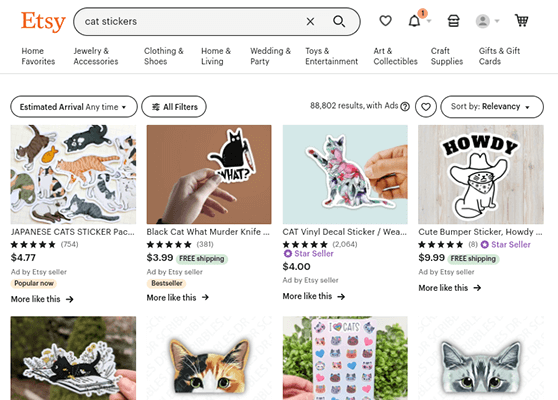
This only explains half of how the Etsy search engine works. Search results on Etsy don’t simply list relevant products at random.
There’s an internal ranking system working behind the scenes determining which products to list first and an order to list the rest in.
Here are Etsy’s top ranking factors. They’re all important for Etsy SEO:
- Relevancy – How well your tags, titles, attributes and categories match a shopper’s search query. Exact matches rank higher in search results.
- Listing Quality Score – How well your product listings convert. Etsy wants to know how many shoppers view your product versus how many go on to buy it. The higher the number, the higher you rank in search results.
- Recency – Etsy gives search ranking boosts to new listings as a way to gauge shoppers’ attitudes towards them. This boost lasts anywhere from a few hours to a few days. Renewed listings are given boosts as well, though much smaller.
- Customer and Market Experience Score – A score that tallies all of your feedback, positive and negative, together. Things that affect your score include customer reviews, whether or not your shop page policies are set up, a completed About section, cases against your Etsy shop, and intellectual property infringement violations.
- Shipping Price – Listings that offer free shipping or are available for digital download receive priority in search results. This is due to a survey Etsy conducted in which 50% of buyers reported being less likely to purchase something if they found the shipping cost to be a little higher than they’re used to.
- Translations and Language – Etsy translates your titles and tags automatically. Even so, you’re more likely to rank higher in search results if you add your own translations as they’re often much better than the platform’s automated translations.
- Shopper Habits – Etsy tailors search results to each individual buyer. This means when Buyer A searches for “soy candles,” they’ll see different results when Buyer B enters the same search term. To improve this aspect of Etsy SEO, the platform recommends using the stats it provides to see what buyers are searching for to reach your top and lowest-viewed listings. This will help you optimize underperforming listings.
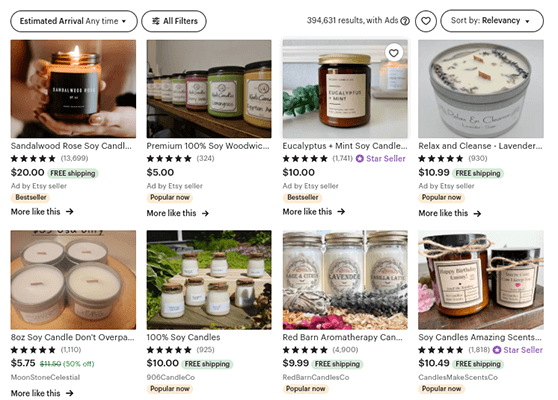
How customers use search on Etsy
Before we get into our list of Etsy SEO tips, let’s see how Etsy search works from a buyer’s perspective. We’ll use “soy candles” as an example.
There are a few different ways a buyer can refine their search before they even start browsing.
First, Etsy provides a row of alternative relevant keywords you can use. Here are a few that popped up for soy candles:
- soy candles handmade
- soy candles in jars
- soy candles wax
- soy candles set
- soy candles flowers
- soy candles bulk
Each one represents a related keyword buyers have searched for.
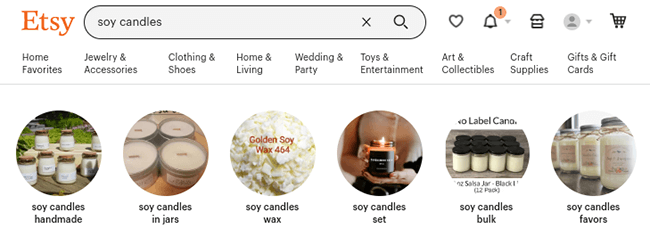
If you look just below this row of keywords, you’ll notice three additional ways buyers can sort and filter Etsy search results:
- Estimated Arrival – How soon a buyer can expect to receive their item if they order today. Buyers have five options to choose from: any time, three upcoming dates and a custom date.
- Sort by – Buyers can sort Etsy search results by relevance, lowest price, highest price, recency and customer reviews.
- Filters – Filters include Estimated Arrival and Sort by, but they also include query-specific filters. For soy candles, filters included Wax Type, Occasion, Color and Scent.
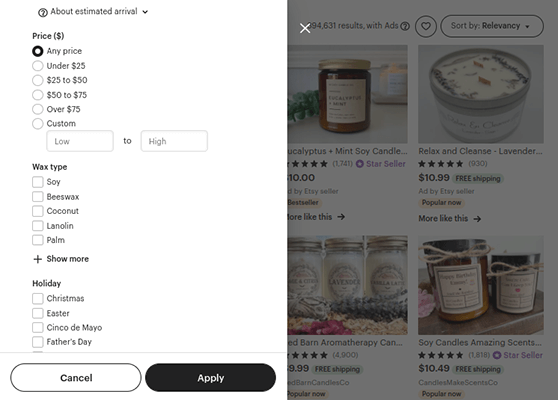
Keep all of this in mind as we work through our list.
11 Etsy SEO tips to stand out on the platform
To improve your Etsy shop’s SEO follow these 11 tips below:
- Offer desirable, in-demand products.
- Choose a searchable shop title.
- Use keywords in product titles.
- Do not use the same title for multiple products.
- Optimize product descriptions for search.
- Use tags strategically.
- Add keyword to the beginning of each field.
- Renew listings to provide a temporary boost.
- Name your Etsy store sections accordingly.
- Consider external search engines.
- Build backlinks for your Etsy shop and product listings.
1. Offer desirable, in-demand products
Make a list of all of the products in your Etsy shop or all of the products you want to sell.
Think of a way to turn the product into a single primary keyword, such as “sun dress.”
Finally, input this keyword into Etsy’s search bar and see what comes up.
What you’re looking for are the number of results that come up as well as the number of reviews each listing has received.
You should also look for “Popular now” and “Bestseller” tags.
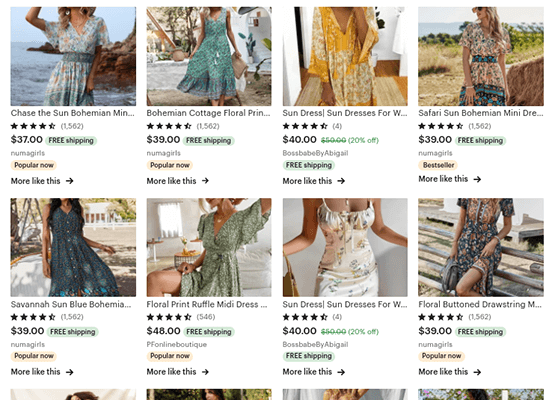
All of these combined will help you determine how desirable the products you want to sell are. The more results and bestselling listings there are for a keyword, the more in-demand it is.
If that number is too high, say tens of thousands or even hundreds of thousands of results, you’re likely looking at an oversaturated niche. Getting noticed in an oversaturated niche can be just as hard as finding success in a niche that’s not popular enough.
You can also use keyword research to determine a product’s popularity, but we’ll get to that in tip #3.
2. Choose a searchable shop title
One thing we didn’t cover earlier is a suggestion that pops up when buyers use the search bar.
This option says “find shop names containing ‘keyword’.”
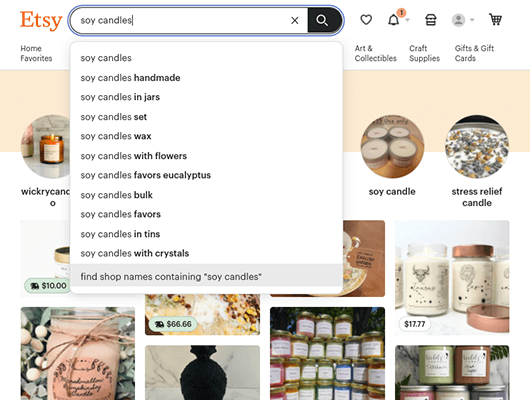
When a buyer clicks on it, they’re shown Etsy shops related to their keyword.
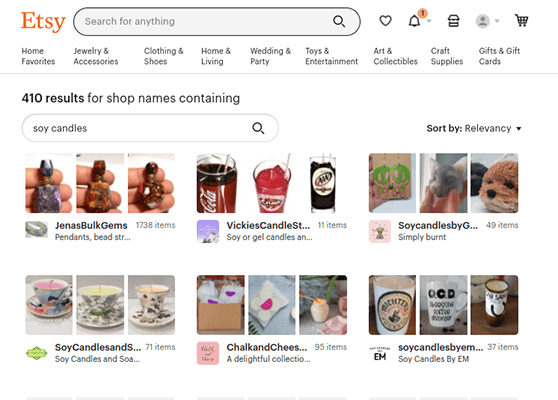
So, while not absolutely necessary, you may want to hone in on your niche and name your shop after it to make it more searchable.
3. Use keywords in product titles
We know from Etsy’s help docs that exact matches rank higher in search results. Therefore, it’s best if you use the top keyword your target buyer searches for to find your product.
A quick way to find the best keyword is to jot down a few keyword ideas for your product and input them into Etsy’s search bar.
A more accurate way to find keywords to use on Etsy is through an Etsy keyword research tool.
One such tool is eRank.
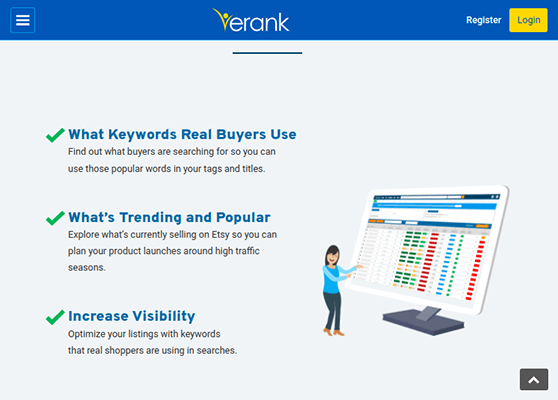
At minimum, eRank enables you to view a keyword’s search volume, popular tags, common price points and suggestions for long-tail keywords.
At most, eRank contains Etsy SEO tools that will audit your listings, report changes to listings, allow you to build keyword lists for easy tracking, help you run competitive analyses against other Etsy sellers, and keep you up to date with the hottest keywords.
But let’s stick to keyword research for now.
How to use eRank for keyword research
As soon as you log in, you’ll notice the Trend Buzz list, a snapshot of the top 100 keywords buyers searched for over the last week. Beside this is a list of yesterday’s top Etsy sellers.
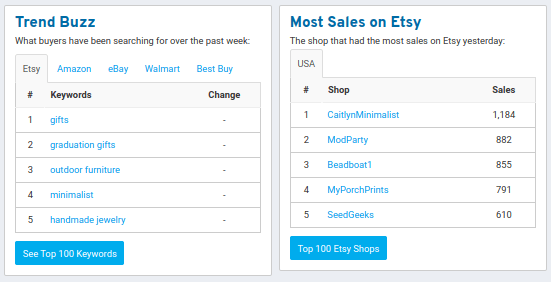
Moving our focus back to the top of the tool, enter your keyword in the search bar.
eRank will output the following keyword statistics for your query:
- Average (Avg) searches – Number of searches per month based on 12 months of data.
- Avg clicks – Number of clicks per month based on 12 months of data.
- Avg click-through-rate (CTR) – Clicks to searches ratio based on 12 months of data.
- Competition – Number of results plus a color code for how difficult it is to rank for the keyword. Green for easy, orange for possible and red for difficult.
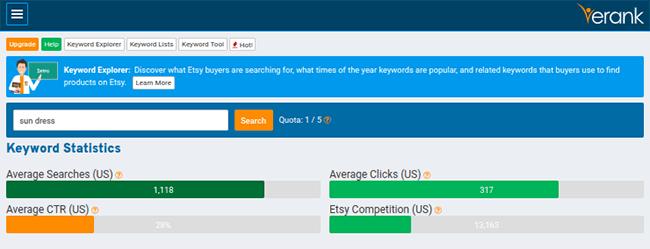
The data will let you know how popular your keyword ideas are as well as how difficult it is to rank for them.
Beneath the Keyword Statistics section are related keywords for the query you entered.
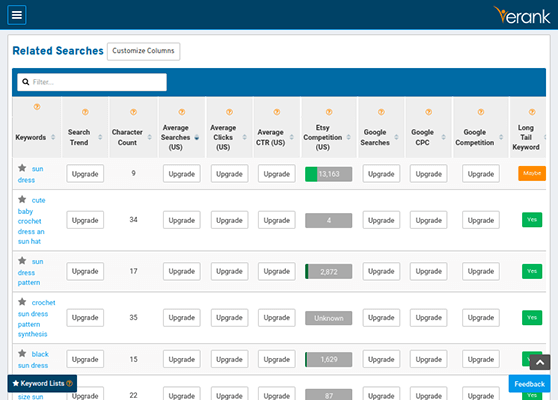
This data includes character count, Etsy competition, and a yes/no/maybe answer for whether or not the phrase is a long-tail keyword. You’ll need to upgrade to view additional data.
eRank has another keyword tool simply called “Keyword Tool.”
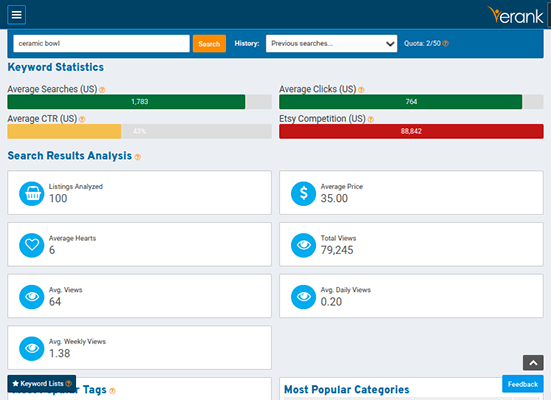
This tool reveals a lot more data about your keyword in addition to the data listed above:
- Listings analyzed
- Avg price
- Avg hearts
- Total views
- Avg views
- Avg daily and weekly views
- Most popular tags
- Most popular categories
- Keyword ideas

eRank is a simple tool, but it’ll change the way you find keywords for your Etsy listings.
4. Do not use the same title for multiple products
Ecommerce solutions like Etsy have product attributes for a reason. They prevent sellers from having to create multiple listings for the same product.
If you sell a yellow sun dress and a red sun dress, you don’t need to create multiple listings for them. You just need to create one “Sun Dress” listing, then add “yellow” and “red” as attributes.
Customers are able to select which color they’d like to purchase on the listing page itself.
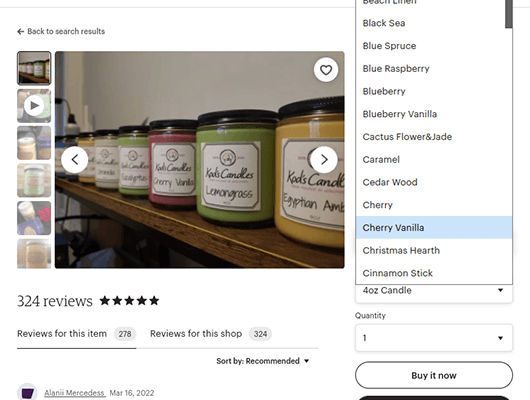
Use product attributes in place of creating multiple listings for the same product to avoid using the same title for multiple products.
If you create two of the same product that look different enough to need separate listings, find a way to give each listing a unique product name.
Let’s use a potter with two ceramic bowl designs as an example. They’re both ceramic bowls, but their designs are too different to share a listing.
Instead of creating two listings that simply say “ceramic bowl,” the potter should give each bowl a unique name using its design or purpose:
- Cereal bowl
- Ramen bowl
- Decorative bowl
- Salad bowl
- Serving bowl
- Footed bowl
The term is called “keyword cannibalization” outside of Etsy SEO. In short, you don’t want your own listings competing with one another.
Target a unique keyword for each listing instead.
5. Optimize product descriptions for search
Use your target keyword in your listing’s product description. Try to include related keywords as well.
Use an organic voice. Write your description in complete, human-friendly sentences, and insert your keywords naturally.
6. Use tags strategically
Etsy listings have a section dedicated to tags. These are descriptive words and phrases you can assign to your listing for color, style, shape, function, etc.
They’re optional, but filling them in can really do a lot to improve your product’s search ranking. This is because Etsy’s search algorithm uses tags to determine how relevant your products are for particular keywords.
Use all 13 tags Etsy allows. And, just like keywords, use long-tail phrases for tags.

Create tags for colors, function, shape, style, synonyms and regional phrases.
Don’t worry about creating tags for plural versions of your keywords. Etsy looks at the root of your keyword. This means listings that only contain the word “dress” will still appear even when buyers search for “dresses.”
Regional phrases should be in the language you target on Etsy. For example, if you create a listing for a chip bowl, add a tag called “crisp bowl” to target British shoppers.
Finally, tags should be unique to each listing.
7. Add keyword to the beginning of each field
If you’ve used Yoast and similar SEO plugins, you’re aware of the emphasis on inserting your keyword at the beginning of a blog article as well as your SEO title.
Etsy SEO works the same way.

Placing your keyword at the beginning of your product title and description can help the platform’s algorithm match your product to a buyer’s search query more efficiently.
While it certainly won’t be the deciding factor between what makes you rank and what doesn’t, it does keep your listings competitive.
8. Renew listings to provide a temporary boost
We know from Etsy’s help docs that creating new listings and renewing your listings provides a temporary boost in search rankings.
Therefore, it’s recommended you get into the habit of renewing your listings semi-regularly to take advantage of this boost.
But keep in mind that Etsy warns against this tactic being an effective strategy for Etsy SEO.
They recommend focusing on optimizing your tags and improving your conversion rates instead.
Renew listings by going to Shop Manager > Listings.
9. Name your shop sections accordingly

Shop sections are groups you can organize your products into. They’re optional, but they make it easier for shoppers to browse your store.
You can create sections by going to Shop Manager > Listings > Manage > Add Section.
All shops have an All Items section by default, but you can add 20 more.
You can only add a listing to one section, so it’s important to choose your sections wisely.
Name your sections after primary keywords. If you’re a potter, this could be “ceramic bowls,” “coffee mugs,” “dinner plates,” etc.
As you can see, your sections should also be a way for you to organize your products into specific categories. This should be done so that each product only fits under one category.
For example, it wouldn’t make sense to add your ramen bowl product listing to the “Coffee Mugs” section.
10. Consider external search engines
Etsy listings do appear in regular search results as well, especially Google Search.
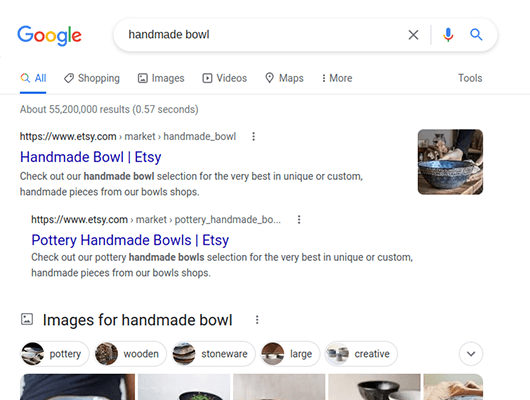
It may be worth doing regular keyword research to see if you can find common keywords between Etsy and Google.
SE Ranking, KWFinder and Semrush are all great keyword research tools.
11. Build backlinks for your Etsy store and listings
Another way to improve your shop’s appearance in search engines beyond Etsy is by building backlinks for it.
At a basic level this will mean linking to your Etsy store from your blog, and social accounts. At a more advanced level, this will mean using blogger outreach to encourage other creators to link to your store.
But don’t stop at backlinks.
Consider sponsoring influencers and bloggers by paying for sponsorship spots or sending them a press release box full of your products.
They’ll either showcase your product in one of their videos or blog posts or create dedicated content for it.
Either way, links from other websites will help you direct traffic to your Etsy store and product pages as well as build backlinks for them.
You can learn more about link building in Adam’s article on link building statistics.
Final thoughts
Etsy SEO isn’t difficult to master. A few tweaks here and there can really change the way your listings appear in search results.
The biggest takeaways from this list should be to offer desirable products and to choose your keywords carefully.
A tool like eRank can help you with both. Keyword research tools designed for Etsy help you pick out products that are in demand and non-competitive.
They also help you pick out the best keywords to use for product listings.
Keep in mind that Etsy does take reviews and customer complaints into consideration.
This means that, above all, you should be doing everything you can to ensure you offer the best products around as well as great customer service.
Related Reading:
- 35 Best Digital Products To Sell On Etsy
- 12 Best Etsy Alternatives & Competitors (Comparison)
- 13 Top Etsy Statistics You Need To Know
Disclosure: Our content is reader-supported. If you click on certain links we may make a commission.
